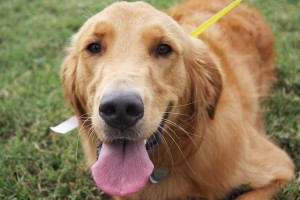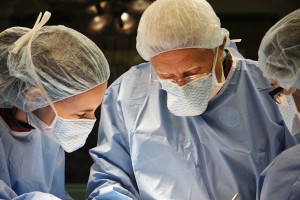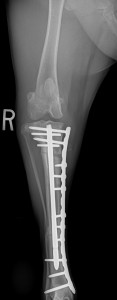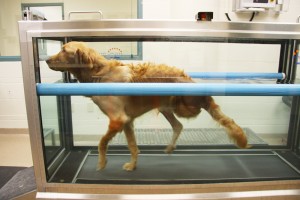Jan Knoche loves golden retrievers. Since she co-founded Love a Golden Rescue in 2001, the St. Louis-based organization has rescued more than 1,000 surrendered, abandoned or abused golden retrievers.

When three-legged Keeper began developing problems walking, owner Jan Knoche brought him to the University of Missouri Veterinary Health Center to see if veterinarians there could do anything to help.
So when Knoche heard Sydney’s story, she took action. At three months old, the puppy was run over by a lawnmower, and his left hind leg was amputated. The owner decided euthanasia was the best option.
Luckily for the young golden retriever, Knoche got involved. The owner was persuaded to surrender the dog, who then traveled from his former home in Kentucky to St. Louis, where Knoche lives.
When she adopted him July 13, 2013, Knoche decided he deserved a new name to go with his new life: Keeper.
She quickly came to love him.
“He’s just a gentle giant,” she said. “He’s never met an enemy.”
Unfortunately, as Keeper grew, he began having difficulty using his remaining back leg. He didn’t appear to be in pain, but he walked abnormally on the leg, often choosing to scoot around instead. Knoche’s local veterinarian suggested Keeper try physical therapy using an underwater treadmill, but still the dog struggled to use his leg and tired easily.
Keeper’s surgery involved two cuts to the tibia to straighten the bone. His surgery team included, from left, Jessica Knapp, DVM, small animal surgery resident; James Tomlinson, DVM, MVSc, professor of small animal orthopedic surgery; and Tori St. Cin, fourth-year veterinary student.

Keeper’s surgery involved two cuts to the tibia to straighten the bone. His surgery team included, from left, Jessica Knapp, DVM, small animal surgery resident; James Tomlinson, DVM, MVSc, professor of small animal orthopedic surgery; and Tori St. Cin, fourth-year veterinary student.
Because another of her dogs had previously received treatment at the University of Missouri Veterinary Health Center, Knoche decided to see if veterinarians there could do anything to help.
“We wanted to give him a chance,” she said.
At the VHC, radiographs and computed tomography (CT) scans were performed to assess Keeper’s tibia and identify how best to help him. Keeper had an uncompensated biapical deformity, in which two deformities of the bone occur in the same direction. This type of deformity results in the knee being positioned to the outside of the body when the foot is placed directly under the pelvis, making it hard for him to balance and support his weight.
James Tomlinson, DVM, MVSc, MU professor of small animal orthopedic surgery, said most dogs do well with only three legs. But Keeper’s accident likely damaged the growth plate at the top of his tibia, causing one side of the growth plate to grow but not the other side, Tomlinson said. This led to his right hind leg being crooked.
Dogs generally distribute about 60 percent of their weight to the front legs and 40 percent to the back, Tomlinson said. Following a hind leg amputation, most shift their weight so about 70 percent is distributed to the front legs. Keeper was unable to do this.
“His back leg was so crooked that he couldn’t shift his weight,” Tomlinson said. “He couldn’t get himself up or support himself.”
Tomlinson worried that Keeper’s mobility problems, if not addressed, would worsen as the young dog grew older and gained weight. His quality of life could decline further. To prevent this, Tomlinson devised a plan to straighten Keeper’s leg so it could bear weight.
Keeper’s bone needed to be as strong as possible to keep it straight while it healed. As seen in this radiograph, his surgeons implanted an interlocking nail secured with three bolts as well as a bone plate secured with 10 screws.

Keeper’s bone needed to be as strong as possible to keep it straight while it healed. As seen in this radiograph, his surgeons implanted an interlocking nail secured with three bolts as well as a bone plate secured with 10 screws.
“Even when dogs have these types of deformities, there are things that can be done to help them have a better quality of life,” Tomlinson said. “Obviously, he’s not going to be 100 percent normal, but hopefully being a three-legged dog he will be acceptably functional.”
Keeper’s surgery involved two cuts to the tibia to straighten the bone. The first, called a proximal osteotomy, was made across the width of the top portion and packed with a bone graft from Keeper’s left front leg. In the second, called a distal wedge ostectomy, a wedge-shaped portion of bone was removed near the bottom of the tibia.
Because Keeper only had the one back leg, it was imperative that the bone be as strong as possible to keep it straight while it healed. To ensure this, Keeper’s surgeons implanted an interlocking nail secured with three bolts as well as a bone plate secured with 10 screws.
The surgery was uneventful, but it was only the beginning of Keeper’s recovery. Because Keeper enjoyed playing with Knoche’s other dogs, which would not have been conducive to his recuperation, Knoche decided to keep him at the VHC for the first month.
About two weeks after surgery he began physical therapy on the VHC underwater treadmill to help him regain his strength and learn how to use his new and improved leg. Adrienne Siddens, a registered veterinary technician and certified canine rehabilitation practitioner, worked with Keeper on the treadmill.
Siddens described Keeper as a “goofball” who initially was more interested in playing than walking while on the treadmill.
“He thinks everybody should play with him, everybody should pet him, everybody should love him,” she said, adding that he was easy to love.
Although Keeper was reluctant to stand on his leg at first, eventually he grew more comfortable on the treadmill, Siddens said. The buoyancy of the water relieved him from having to bear all his weight, and the resistance helped build muscle strength. The more he walked, the more the range of motion in his hip improved.
In addition to the physical benefits, the treadmill also increased Keeper’s confidence in his ability to walk.
“His mind got retrained,” Tomlinson said. “He was so used to scooting, but he got to the point where he realized, ‘I can do this. I can bear weight.’”
After Keeper went home to St. Louis, Knoche continued his water therapy at a local facility. Over the next couple of months, his walking became noticeably better, while other, less visible changes occurred. Radiographs show that the two cuts to his tibia have healed and filled in with bone.
Today Keeper, who will be 2 in April, is active and happy, Knoche said. She walks him twice a day and still takes him to water therapy once a week to give him additional exercise.
Physical therapy on the VHC underwater treadmill helped Keeper regain his strength and learn how to use his improved leg.

Physical therapy on the VHC underwater treadmill helped Keeper regain his strength and learn how to use his improved leg.
Tomlinson said Knoche’s commitment to caring for Keeper and giving him a good quality of life was instrumental in his recovery.
Knoche, who has rescued many dogs with health problems, said it is heartwarming to watch them blossom as they receive the loving treatment and homes they deserve. She said she is grateful for the attention and care Keeper received at the VHC.
“We felt if any place could give us a miracle for Keeper it would be (the VHC),” she said. “We have got our miracle, I believe, and we are so thankful.”
In his final appointment at the VHC, Keeper shows off his new ability to support himself and walk using his hind leg.



